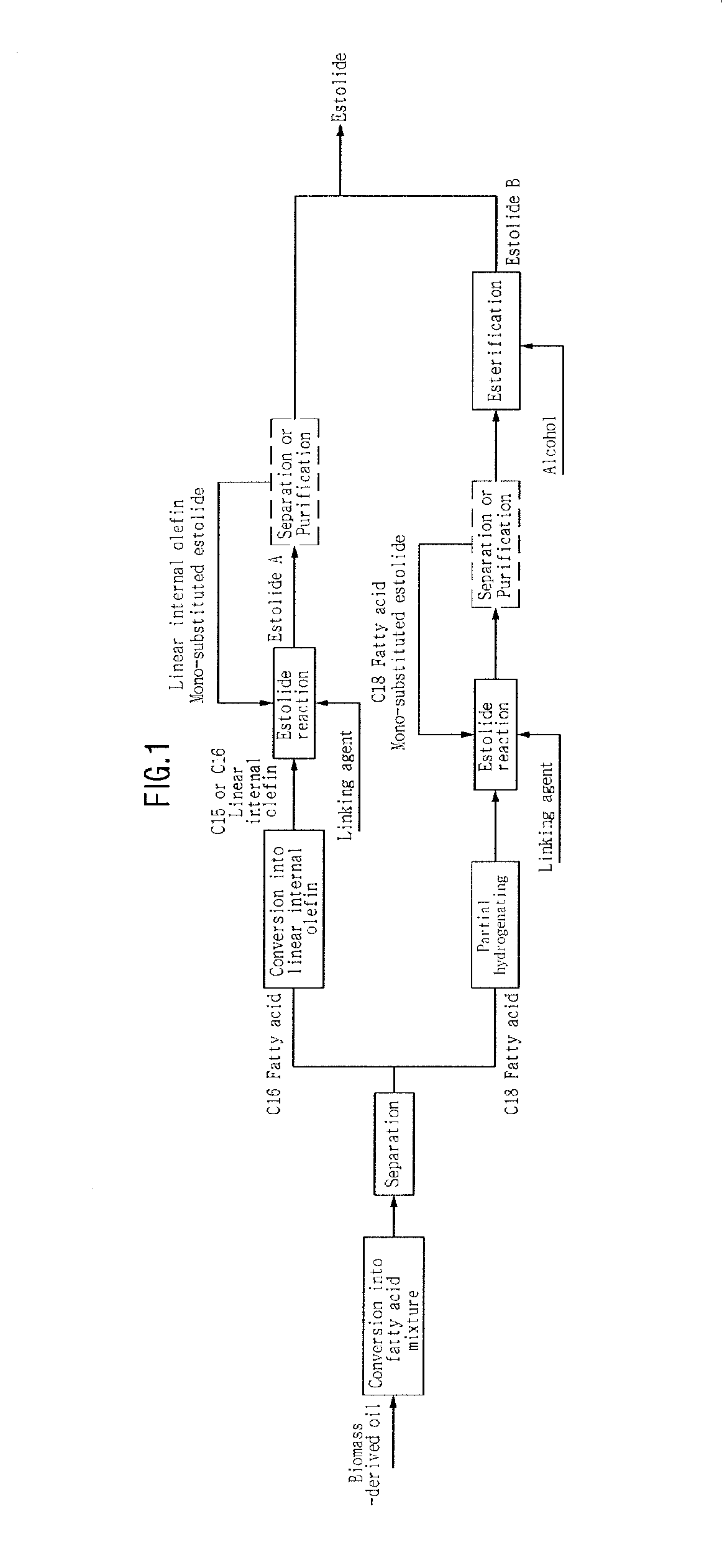Method of producing estolide using linking agent
a technology of estolide and linking agent, which is applied in the direction of fatty acid production, hydrocarbons, fatty acid chemical modification, etc., can solve the problems of ecological disturbance caused, low biodegradability of lubricants, and high biodegradability of estolides, and achieves high biodegradability, high steric hindrance, and difficult conversion of ester into acid
- Summary
- Abstract
- Description
- Claims
- Application Information
AI Technical Summary
Benefits of technology
Problems solved by technology
Method used
Image
Examples
example 1
[0101]A. Separation of Fatty Acid
[0102]The composition of PFAD (palm fatty acid distillate) was analyzed through SimDist, and 2.2 kg of PFAD was placed in a TBP cutting device, and fatty acids were thereby separated depending on the reaction temperature. Based on the results of SimDist analysis of PFAD, the pattern of FIG. 3 appeared.
[0103]PFAD was cut at 300° C., 355° C. , and 380° C., thus obtaining individual fatty acids in the amounts shown in Table 2 below.
TABLE 2Fatty acidPFAD composition (wt %)14:0 Myristic acid316:0 Palmitic acid4318:1, 18:2, 18:338Oleic acid, Linoleic acid, Linolenic acidMono-glyceride, Di-glyceride16Total100
[0104]The PFAD sample was separated into myristic acid (b.p. 380° C.) through cutting at 300° C., 355° C., and 380° C. The amounts of the fatty acids thus separated are shown in Table 3 below.
TABLE 3Fatty acidSeparated sample amount (g)14:0 Myristic acid5916:0 Palmitic acid95718:1, 18:2, 18:3807Oleic acid, Linoleic acid, Linolenic acidMono-glyceride, Di...
example 2
[0124]440.0 g of the C16:0 fatty acid obtained through fatty acid separation in Example 1 was placed in a 4 L autoclave reactor, after which 20.4 g of FeCl2 anhydride, 168 g of triphenylphosphine, and 163.2 g of acetic anhydride were sequentially added and physically mixed together. The mixture was purged two times with N2, and N2 was charged at a pressure of 20 bar, whereby the total reaction pressure was set to 20 bar. Subsequently, the temperature was raised to 240° C. and maintained for 10 min, and then the reaction was shut down.
[0125]The recovered catalyst and the reaction product were filtered, thus separating the catalyst lump from the reaction product. Thereafter, the catalyst was separately stored so as to be reused, and the filtered reaction product was mixed with 2 L of DI water and stirred overnight. Thereafter, the reaction product was separated from DI water using a separator funnel, and the separated reaction product was further filtered using Celtic powder. The reac...
PUM
| Property | Measurement | Unit |
|---|---|---|
| pour point | aaaaa | aaaaa |
| wt % | aaaaa | aaaaa |
| wt % | aaaaa | aaaaa |
Abstract
Description
Claims
Application Information
 Login to View More
Login to View More - R&D
- Intellectual Property
- Life Sciences
- Materials
- Tech Scout
- Unparalleled Data Quality
- Higher Quality Content
- 60% Fewer Hallucinations
Browse by: Latest US Patents, China's latest patents, Technical Efficacy Thesaurus, Application Domain, Technology Topic, Popular Technical Reports.
© 2025 PatSnap. All rights reserved.Legal|Privacy policy|Modern Slavery Act Transparency Statement|Sitemap|About US| Contact US: help@patsnap.com



